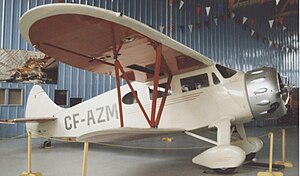Waco C series
| Waco Custom Cabin series | |
|---|---|
 |
|
| Waco EQC-6 marked as Grant McConachie's aircraft | |
| Role | Four to five place cabin sesquiplane |
| Manufacturer | Waco Aircraft Company |
| First flight | 1935 |
| Introduction | 1935 |
| Produced | 1935–1939 |
| Number built | 350+ |
| Unit cost |
1938 ZGC-8 (options unspecified) $10,495 (roughly $171,258.30 in 2012 dollars)
|
| Variants | Waco ZQC-6, Waco E series, Waco N series |
The Waco Custom Cabins were a series of up-market single-engined four-to-five-seat cabin sesquiplanes of the late 1930s produced by the Waco Aircraft Company of the United States. "Custom Cabin" was Waco's own description of the aircraft which despite minor differences, were all fabric-covered biplanes.
Nearly all of the Waco Custom Cabins were powered by radial engines (there being one factory-built exception, the MGC-8) and the purchaser could specify almost any commercially available engine and Waco would build an aircraft powered by it, hence the profusion of designations, as the first letter indicates the engine installed. Some models were offered in case someone wanted a specific engine but not all were built. Fuselage structure was typical for the period, being welded steel tubing with light wood strips to fair the shape in. The wings were made of spruce with two spars each, having ailerons on only the upper wings, mounted on a false spar. Split flaps were installed on the undersides of the upper wings, though two designs were used depending on model – placed either mid-chord (OC, UC and QC), or in the conventional position at the trailing edge of the wing (GC and N). The model N was unusual in being the only model with flaps on the lower wings while the model E was the only one with plain flaps. Wing bracing was with a heavily canted N strut joining upper and lower wings, assisted by a single strut bracing the lower wing to the upper fuselage longeron, except on the E series which replaced the single strut with flying and landing wires. Elevators and rudder were aerodynamically counterbalanced and braced with wire cables. Both could be trimmed, the rudder via a ground-adjustable tab, the elevators via jack screw on the OC, UC and QC, while the GC, E and N used a single trim tab on the port (left) elevator. The main landing gear was sprung with oleo struts, and a castoring tailwheel was fitted on all versions except the VN model, which had a nosewheel.
Waco had been building a series of successful cabin biplanes, when in 1935 they introduced a new series of upmarket cabin sesquiplanes intended for the wealthy private individual or business. The original biplanes had been given a designation ending in C, however with the new Custom Cabin, Waco decided to differentiate the new design and existing C types that remained in production were recoded as C-S types to indicate Standard Cabin, until Waco changed their designation again in 1936 to just an S. For example, the 1934 Standard Cabin YKC was redesignated as a YKC-S in 1935, and as a YKS-6 in 1936. 1936 also saw the adoption of a numerical suffix to indicate the model year of the design, as "-6" for 1936, "-7" for 1937, etc. Since it referred to a model and not the year of production, the "-7" was carried into 1939 for some Custom Cabins, while others were designated "-8". In 1936, Waco started using a short form to refer to the types of aircraft without the engine and model identifiers resulting in C-6, C-7 and C-8 however as Waco only built one type of Custom cabin in each of those years, they refer to the QC-6, GC-7 and GC-8 series respectively.
...
Wikipedia
